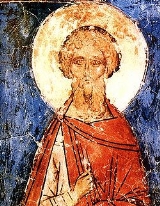
Julian of Antioch
Encyclopedia
Saint Julian of Antioch (sometimes called Julian of Cilicia, Julian of Anazarbus
, Julian of Tarsus
) is venerated as a Christian
martyr
of the fourth century. His date of death is given as 305 AD (or between 305 and 311 AD). He is sometimes confused with another saint of the same name
.
Of senatorial
rank, he was killed during the persecutions of Diocletian
. His legend states that he was subjected to terrible tortures and paraded daily for a whole year through various cities of Cilicia
. He was then sewn up in a sack half-filled with scorpions, sand, and vipers, and cast into the sea. The sea carried his body to Alexandria, and was buried there before being moved to Antioch.
Saint John Chrysostom preached a homily
in Julian's honor at Antioch
, whose basilica
was said to be the final resting place for Julian's relics.
His feast day is June 21 in the Eastern Orthodox Church, March 16 in the Catholic Church.
Anazarbus
Anazarbus in Ancient Cilicia was an ancient Cilician city, situated in Anatolia in modern Turkey, in the present Çukurova about 15 km west of the main stream of the present Ceyhan River and near its tributary the Sempas Su.A lofty isolated ridge formed its acropolis...
, Julian of Tarsus
Tarsus (city)
Tarsus is a historic city in south-central Turkey, 20 km inland from the Mediterranean Sea. It is part of the Adana-Mersin Metropolitan Area, the fourth-largest metropolitan area in Turkey with a population of 2.75 million...
) is venerated as a Christian
Christian
A Christian is a person who adheres to Christianity, an Abrahamic, monotheistic religion based on the life and teachings of Jesus of Nazareth as recorded in the Canonical gospels and the letters of the New Testament...
martyr
Martyr
A martyr is somebody who suffers persecution and death for refusing to renounce, or accept, a belief or cause, usually religious.-Meaning:...
of the fourth century. His date of death is given as 305 AD (or between 305 and 311 AD). He is sometimes confused with another saint of the same name
Julian and Basilissa
Saints Julian and Basilissa were husband and wife. They were Christian martyrs who died at either Antioch or, more probably, at Antinoe, in the reign of Diocletian, early in the fourth century, on 9 January, according to the Roman Martyrology, or 8 January, according to the Greek Menaea.Their...
.
Of senatorial
Roman Senate
The Senate of the Roman Republic was a political institution in the ancient Roman Republic, however, it was not an elected body, but one whose members were appointed by the consuls, and later by the censors. After a magistrate served his term in office, it usually was followed with automatic...
rank, he was killed during the persecutions of Diocletian
Diocletian
Diocletian |latinized]] upon his accession to Diocletian . c. 22 December 244 – 3 December 311), was a Roman Emperor from 284 to 305....
. His legend states that he was subjected to terrible tortures and paraded daily for a whole year through various cities of Cilicia
Cilicia
In antiquity, Cilicia was the south coastal region of Asia Minor, south of the central Anatolian plateau. It existed as a political entity from Hittite times into the Byzantine empire...
. He was then sewn up in a sack half-filled with scorpions, sand, and vipers, and cast into the sea. The sea carried his body to Alexandria, and was buried there before being moved to Antioch.
Saint John Chrysostom preached a homily
Homily
A homily is a commentary that follows a reading of scripture. In Catholic, Anglican, Lutheran, and Eastern Orthodox Churches, a homily is usually given during Mass at the end of the Liturgy of the Word...
in Julian's honor at Antioch
Antioch
Antioch on the Orontes was an ancient city on the eastern side of the Orontes River. It is near the modern city of Antakya, Turkey.Founded near the end of the 4th century BC by Seleucus I Nicator, one of Alexander the Great's generals, Antioch eventually rivaled Alexandria as the chief city of the...
, whose basilica
Basilica
The Latin word basilica , was originally used to describe a Roman public building, usually located in the forum of a Roman town. Public basilicas began to appear in Hellenistic cities in the 2nd century BC.The term was also applied to buildings used for religious purposes...
was said to be the final resting place for Julian's relics.
His feast day is June 21 in the Eastern Orthodox Church, March 16 in the Catholic Church.

